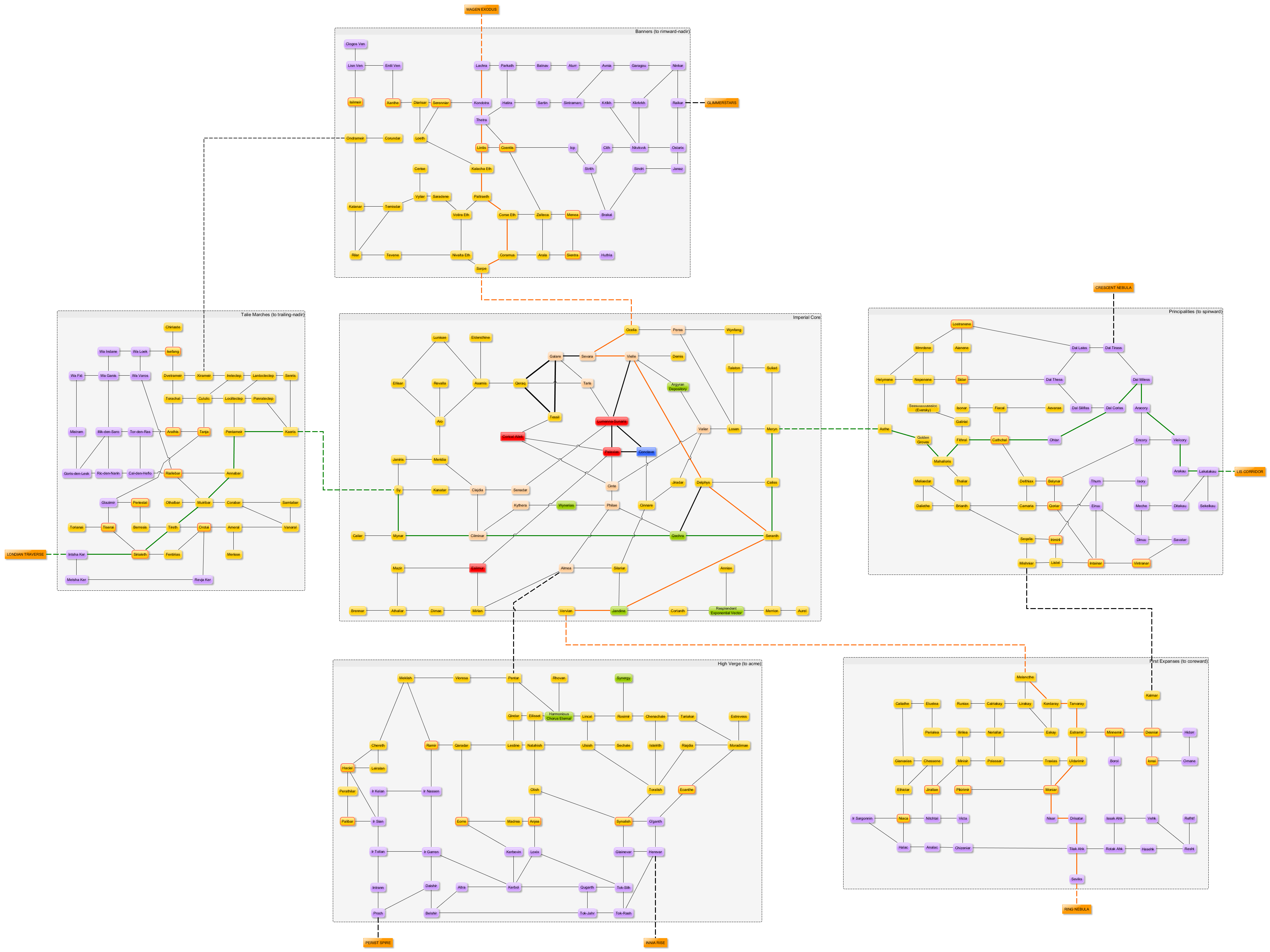So let’s talk a little about the setting of our ongoing fiction, the Associated Worlds.
First: they’re big. Really, really frakkin’ big. Sci-fi writers with a sense of scale big. I mean, you may think it’s a long way down the road to the chemists’, but…
Ahem. Enough of that.
So, let me draw you a picture. The free-space volume of the Associated Worlds is an irregular mostly-oblate spheroid. Along its major axes, it’s about 3,300 light years from core to rim, 4,100 light years from spinward to trailing, and 2,000 light years from acme to nadir. To put some perspective on those numbers, that means that at its tallest part, much of the center, it completely fills the galactic disk top to bottom. Meanwhile, the Lethíäza arm of the galaxy in which it is located is approximately 3,500 light years across, and since one slightly-flattened end of the spheroid – expansion having slowed, although not stopped, to coreward on encountering the inter-arm gap – is pressed up against its coreward side, it lacks only about 200 light years of running into the rimward side of the arm, too.
As those of you with calculators will already know, that’s approximately 27 billion cubic light years of volume, which contains approximately 100 million stellar bodies of various kinds. Like I said, big.
Of course, on the cosmic scale, or even the galactic scale, it’s still a barely significant mote. Space is like that.
The kicker, of course, is that most of that is unused and only explored astronomically. The expansion pattern of the Worlds has been, essentially, to look for interesting things, and then fire off a long-range stargate to a system near them and weave a constellation from there. The one black hole in our neighborhood? That counts. The blue-white supergiant? That counts, too. Any system which appears to have signs of intelligent and usually technological life? That definitely counts, as maybe we can sell ’em something. That sort of thing.
That process has resulted in maybe 10,000 star systems over that whole enormous volume being actually connected to the stargate plexus and thus readily visitable. That would be roughly 0.01% of the stellar bodies in that volume. The rest would be the “Inner Periphery” of systems that didn’t seem so interesting at the time but which are likely to be hooked up if and when they become interesting, or if and when polities in inner constellations feel like expanding locally, rather than out in the ecumene, and also feel like paying for it.
So when you think of the Associated Worlds, think of a cobweb. The strands are long-distance wormholes. The dewdrops clinging to the points where they intersect are local constellations, where constellation in this case is defined as maybe fifty systems linked together with short-range stargates with three or four long-range gates connecting to it at various points. And the empty spaces are not-quite-empty space.
To hang some numbers on that, the Empire has all of one constellation (the Imperial Core), and about half each of five more (the Imperial Fringe), close to 250 worlds in total if you include its colonies out in the ecumene. Which is to say, it’s the tiny kernel at the heart of the big nut – although that said, it’s nearest competitors, the Photonic Network and the League of Meridian, are only 120-150 world polities. To divide up the rest, in the divisions Where’s Where in the Galaxy would offer you, these six constellations and 73 more make up the “true” Associated Worlds, the well-developed, comfortable, and stable metropolitan regions.
109 more constellations surrounding those make up the Expansion Regions, which are a bit less developed but not actually frontier. They tend to be the places where most of the action is, when there’s astropolitical action.
And the 23 constellations of the Periphery, found all around except to acme, nadir, and along the border with the Republic, are the wild and wooly frontier.
Leaving the Worlds proper for a moment, the Voniensa Republic, featuring rather heavily at the moment, is located spinward and slightly to rimward. It has about 8,000 worlds in its volume, although by no means all of those are politically part of the Republic. (More than a few of them belong to people who are currently being Prime Directed, for a start.) It’s also substantially smaller than the Worlds in free-space volume, because while they’re not quite as bad at insisting territorial volumes make sense in space as the members of the Interstellar League of Tribal Chiefdoms, they do pursue a much more consolidate-y expansionary policy.
And finally to note, cutting through the rimward systems of Lethíäza, and thus both the rimward side of the Republic and the fringe Periphery – only a few stargates at the far edge of the rimward Periphery breach it – is the Shadow Veil, which is a vast dark nebula of opaque gas and dust that does a fine job of obscuring both the view further rimward from most of the Worlds, and vice versa.
(So even if its still flexible galactic location turns out to be directly coreward of us, there’s still a reason why our astronomers *there* aren’t getting all excited about those distinct signs of someone building megastructures and operating pion drives. Heh.)

